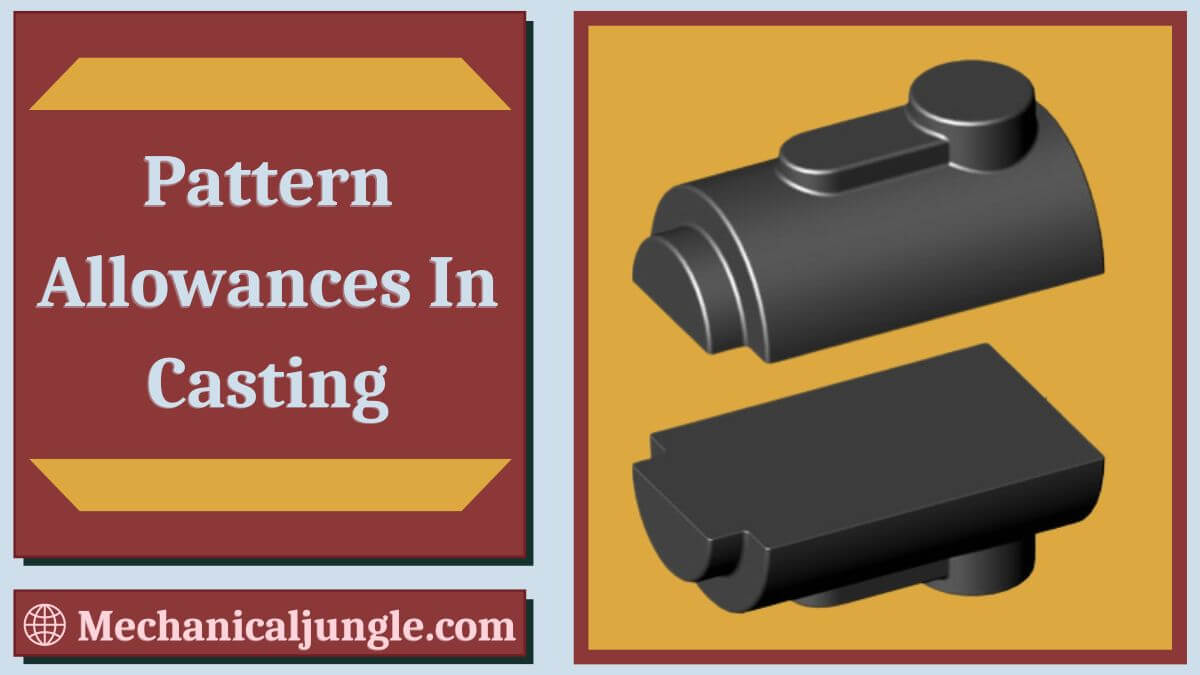
Pattern Allowances In Casting:
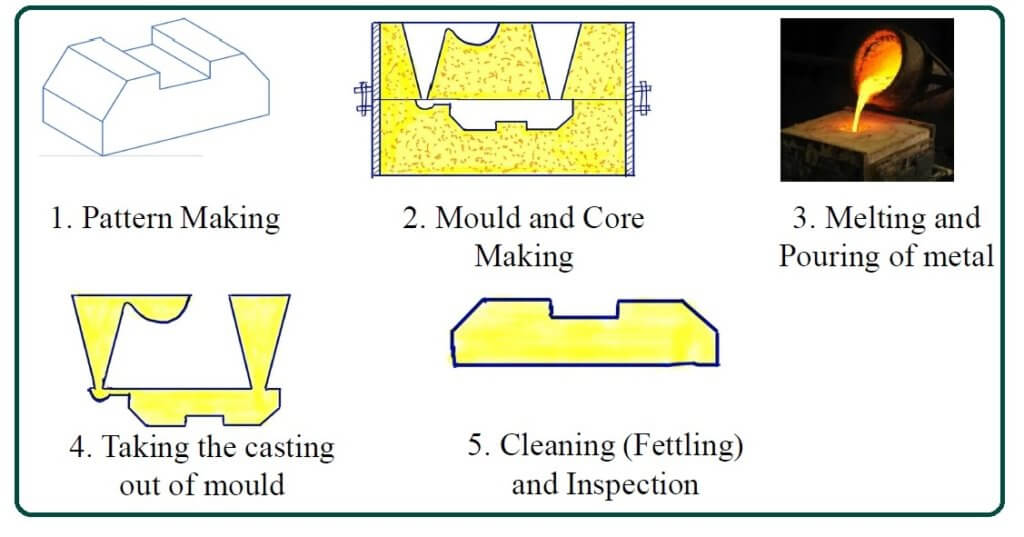
- A pattern is a replica of the casting but has slightly larger dimensions.
- This change in pattern in casting for various reasons is known as pattern allowance in casting.
Example for Pattern Allowances In Casting
- When the cast freezes, the metal shrinks to some extent due to the shrinking property during cooling. Therefore, a pattern is made slightly larger to compensate for this.
- This is an example of pattern allowance. There are several other reasons for pattern allowances, which will be discussed below.
Why the Pattern Allowances in Casting Affected?
- Sometimes the patterns are not the same size as the desired casting size. To Compensates for the patterning process, allowances are made in the pattern, removing the pattern, dimensional and structural changes during casting.
- The different types of pattern allowances in casting are as follows. Shrinkage allowance is the most common of possible castings for casting.
Casting of Pattern Allowances
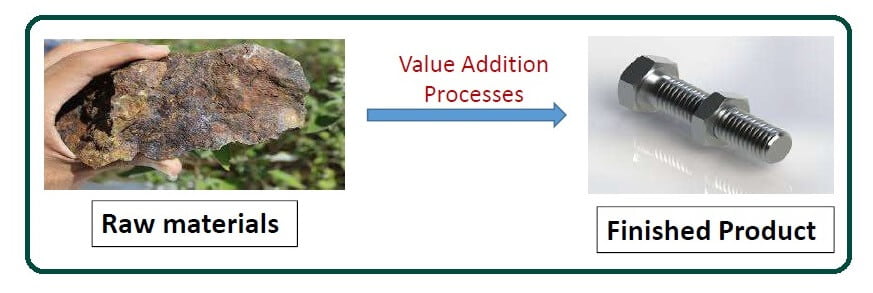
- Casting is one of the earliest manufacturing processes known to human beings.
- In casting, molten metal is solidified to the desired shape and size.
- Castings are often the cheapest and most direct way of shaping the metal.
- Practically, any intricate shape can be produced.
- With a normal sand casting process, the dimensional accuracies and surface finish
is poor. - Defects are inevitable.
Typical Pattern Make’s Shrinkage of Various Metals:
| Sr.No. | Metal alloy | Solidification shrinkage (Volume %) | Cooling shrinkage (Volume %) | Solidus Temperature (⁰C) |
| 1 | Al | 7.1 | 5.1 | 660 |
| 2 | Cu | 5.1 | 6.4 | 1083 |
| 3 | Fe (pure) | 3.5 | 6.0 to 7.5 | 1535 |
| 4 | Steel | 2.5 to 3.0 | 4.2 to 6.0 | 1500 |
| 5 | Ductile cast iron | -4.5 to +2.7 | 3.0 | 1148 |
| 6 | Gray cast iron (2% c) | 1.05 | 1.0 | 1155 |
| 7 | Zn | 4.7 | 4.0 | 420 |
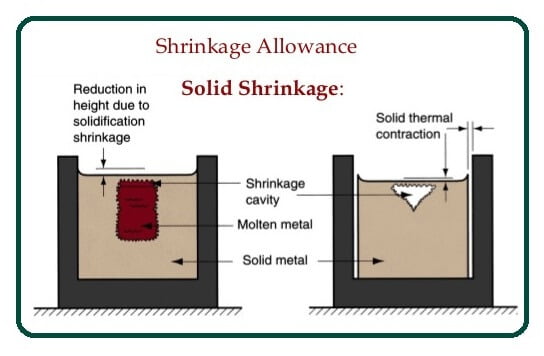
- It can also be classified into solid shrinkage and liquid shrinkage.
- The volume decreases during the process of metal freezing called solid shrinkage.
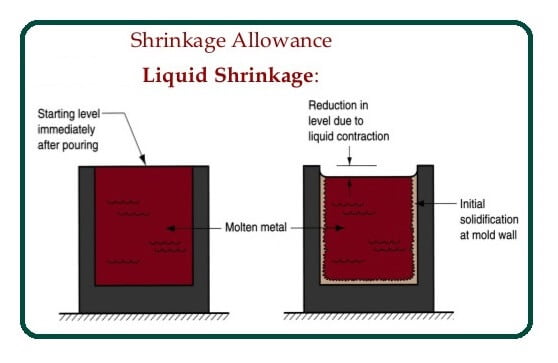
Allowance in Casting Process:
The volume is reduced during the metals cooling process is called liquid shrinkage.
Draft Allowance
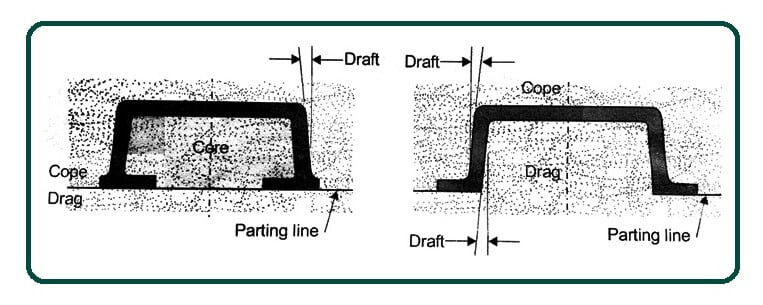
- The leading edge likely breaks or is damaged during removal from the mold. In order to be avoided, the taper is to allow on the pattern and easily remove from the edge of the mold.
- This taper has some angles called draft angles. The draft angle depends on the type of molding, height, and complexity of the pattern.
Finishing or Machining Allowance:
- They produce chunks using the sand casting method. The surface finish of the part will be poor.
- So it avoids, during the machining process, the molding of the product is twisted or ground together on the surface to improve the surface finish, removing some substantial amount of metal from the mold part.
- To compensate for this, machining or finishing allowances are given in the casting. This allowance is added together to the original shape of the pattern.
Based on the amount of allowance added to the pattern,
- Type of the machining process
- Material used
- Accuracy required
- Molding method
It varies from 2 mm to 15 mm depending on the size and material of the part. For very large machining allowances to increase the cost of molten metal and to remove more of the metal from the mold part by machining.
Shake or Wrapping Allowance:
- The pattern is removed from the mold cavity, sometimes wrapping the pattern for easy removal from the cavity. In this case, the final mold cavities are enlarged.
- So to compensate for the enlargement, the amplitude of the pattern must be reduced. This is called a shake or wrapping allowance.
Distortion or Camber Allowance:
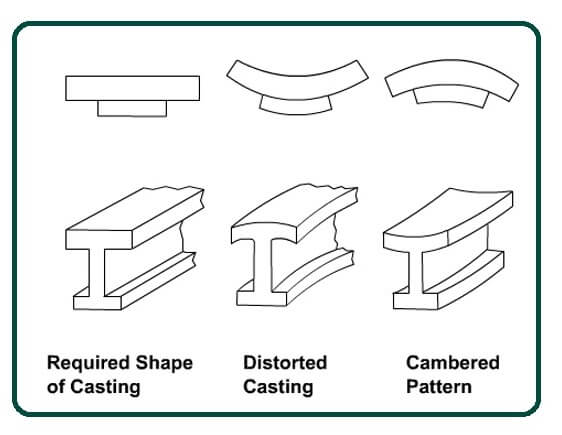
- When the mold is in a cooling process, tension is developed into a solid metal due to uneven metal thickness or over-cooling to allow for casting.
- These stresses can induce deformation or bend in the castings. This can be avoided by initially distorting patterns in the opposite direction.
- The thickness of the casting part is uneven. Therefore, the solidification process section does not have a uniform thermal stresses.
- Therefore those castings are deformed. Avoid that, the chamber provided in the opposite direction.
Frequently asked questions (FAQs) that could be included in your article on pattern allowances in casting:
What are pattern allowances in casting?
Pattern allowances refer to intentional variations in the dimensions of a pattern used in casting to compensate for factors like shrinkage, machining, and ease of mold removal.
Why are pattern allowances necessary in casting?
Pattern allowances ensure that the final cast product meets dimensional accuracy requirements after accounting for material shrinkage during cooling and additional machining or finishing processes.
What are the different types of pattern allowances?
Pattern allowances include shrinkage allowance (solid and liquid), draft allowance, machining or finishing allowance, shake or wrapping allowance, and distortion or camber allowance.
How do pattern allowances affect casting processes?
Pattern allowances influence the accuracy of the final casting dimensions, the ease of mold removal, and the surface finish quality of the cast part.
How are pattern allowances determined?
The size and type of pattern allowances depend on factors such as the type of metal alloy used, the complexity of the casting, the molding method employed, and the required dimensional accuracy of the final part.
What is the role of draft allowance in casting?
Draft allowance, characterized by draft angles, helps in easy removal of the pattern from the mold and prevents damage to the mold cavity edges during extraction.
Why is machining or finishing allowance necessary?
Machining or finishing allowance ensures that the cast part can achieve the desired surface finish and dimensional accuracy through post-casting machining processes, compensating for the roughness of the casting surface.
How does shrinkage allowance vary with different metals?
Different metals exhibit varying degrees of shrinkage during cooling, which necessitates specific allowances in pattern dimensions to achieve the desired final part dimensions.
What challenges can arise from inadequate pattern allowances?
Insufficient pattern allowances can lead to dimensional inaccuracies, defects in the casting, difficulties in mold removal, and increased post-casting processing time and costs.
How can pattern allowances be optimized for cost-effective casting?
Optimizing pattern allowances involves balancing dimensional accuracy requirements with material usage efficiency and minimizing post-casting machining requirements, thereby reducing overall production costs.

